Top Ant Bug Sprays: Comprehensive Guide for Homeowners


Intro
Ant infestations present a unique challenge for homeowners. Understanding the behavior and characteristics of ants is pivotal for effective control. This guide aims to delve into comprehensive solutions for ant problems, specifically through the lens of bug sprays. Knowing the types of ants you are dealing with and the most effective methods for application can make a significant difference. Moreover, we will explore both chemical and natural options, ensuring that you have the necessary tools for responsible pest management.
Understanding the Pest
Identification
Identifying the species of ant is essential when selecting a bug spray. There are several common types that infest homes, such as:
- Carpenter Ants: Recognized for their ability to hollow out wood.
- Sugar Ants: Attracted to sweet foods and sugary substances.
- Pharaoh Ants: Known for their small size and yellowish color.
Accurate identification allows for better-targeted treatment options. Look for distinguishing features, such as body color, size, and habitat preferences.
Life Cycle
The life cycle of ants consists of four primary stages: egg, larva, pupa, and adult. Understanding this cycle aids in determining the best time for intervention.
- Egg Stage: Ants lay eggs, which can hatch into larvae within a few weeks.
- Larva Stage: Larvae are fed and develop in the colony.
- Pupa Stage: This is a transformative phase where larvae develop into adult ants.
- Adult Stage: Adult ants take on roles like foraging for food or caring for the queen and her young.
Effective pest control often targets ants during their vulnerable larval and pupal stages.
Pest Prevention Strategies
Environment Modification
Preventing ant infestations begins with modifying the environment. Small changes can deter ants from entering the home. Here are several strategies:
- Keep food sealed and stored properly.
- Clean kitchen surfaces frequently to eliminate food residue.
- Seal cracks and openings in windows and doors.
These modifications can create barriers against ant entry.
Physical Barriers
Utilizing physical barriers can also be effective. Options include:
- Installing door sweeps to close gaps under doors.
- Using protective mesh around vents and windows.
- Creating ant trails with talcum powder or diatomaceous earth to dissuade their movement.
Implementing such strategies creates an inhospitable environment for ants.
Control Methods
Chemical Control
When infestations escalate, chemical sprays might be necessary. Several products are designed specifically for ant control:
- Ortho Home Defense Insect Killer for Lawns & Landscape: Targets ants and other pests effectively.
- Raid Ant and Roach Killer: Provides instant action against crawling insects.
- Terro Liquid Ant Baits: Attracts and kills ants effectively, targeting the colony.
When using chemical solutions, it is essential to follow the manufacturer's instructions to ensure safety and effectiveness.
Biological Control
Natural or biological control methods can be safer alternatives for homes with children or pets. Some options include:
- Boric Acid: A common ingredient in many natural ant control products.
- Essential Oils: Products with peppermint or tea tree oil can deter ants when used in sprays.
These methods may take longer to show results but can be safer for the environment and your household.
Ant control requires a multi-faceted approach that combines prevention, treatment, and monitoring to effectively manage infestations over time.
Intro to Ant Problems
Understanding ant problems is critical for homeowners trying to maintain a comfortable living space. Ants are not just a nuisance; their presence often indicates larger issues related to cleanliness and home maintenance. Furthermore, these insects can invade pantries, contaminate food, and pose potential risks to health. This section will explore how ant infestations affect households along with the common types that typically invade homes.
The Impact of Ant Infestations
Ant infestations can create various challenges for homeowners. First and foremost, they can damage property. Some species, like carpenter ants, tunnel through wood, which can lead to structural issues. While not all ants cause damage, the psychological impact of seeing them can be concerning. Homeowners often feel anxious at the sight of ants marching across countertops or in storage areas. Maintaining a pest-free environment is important for personal comfort and peace of mind.
Additionally, certain species can contaminate food supplies. Ants are known to carry bacteria, and the more they wander through your living spaces, the higher the chance of spreading pathogens. This poses health risks, particularly for families with young children or individuals with weakened immune systems.
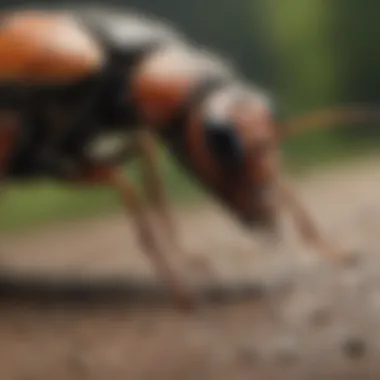
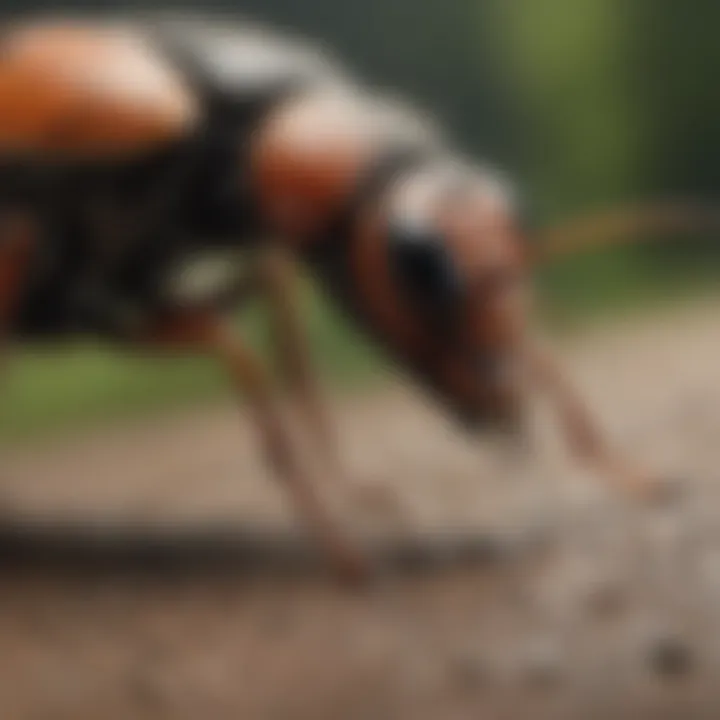
"Effective ant management is essential for preserving a healthy home environment and reducing health risks."
Common Types of Ants Found in Homes
A deeper comprehension of the types of ants common to residential areas can aid in selecting the proper control methods. Here are some of the most frequently encountered types:
- Argentine Ants: These ants are small and dark and are known to form large colonies. They often invade kitchens and require quick management measures.
- Carpenter Ants: Larger than most house ants, they can cause noticeable damage by tunneling through wood to build their nests.
- Odorous House Ants: They emit a smell reminiscent of rotten coconut when crushed. These ants can be particularly persistent and are drawn to food sources.
- Pavement Ants: These ants build their nests in the cracks of sidewalks and driveways but often wander indoors in search of food.
Understanding these common types not only helps in identifying the infestation but also in selecting the right bug spray that fits the specific ant problem. This knowledge enables homeowners to take effective action against these pests.
Understanding Bug Sprays
Understanding bug sprays is essential for anyone dealing with ant infestations. These products are designed to combat various pests effectively, especially ants, which can invade homes in large numbers. Knowledge of bug sprays aids homeowners in making informed decisions regarding pest control. Being aware of the different solutions available allows individuals to choose appropriate methods for their specific situations.
What is Bug Spray?
Bug spray, also known as insecticide, is a chemical product used to kill or repel insects. It typically contains active ingredients that target specific pests. These sprays can effectively eliminate household ant populations and deter future infestations. Bug sprays can be either synthetic or natural, depending on the formulation.
In many cases, bug sprays act quickly to provide instant relief from visible insect problems. They can also offer longer-lasting solutions when used as part of an integrated pest management strategy. This is where understanding the product's nature and purpose becomes vital.
Types of Bug Sprays
There are two main types of bug sprays: chemical and natural.
- Chemical Bug Sprays: These contain synthetic ingredients specifically designed to kill or repel insects. Their formulations often consist of pyrethroids, neonicotinoids, and organophosphates. These chemicals are highly effective and provide rapid results. However, they can pose risks to non-target organisms, including humans, pets, and beneficial insects.
- Natural Bug Sprays: These are made from natural ingredients, such as essential oils or plant extracts. For example, diatomaceous earth, vinegar, and peppermint oil serve as effective ant repellents. They generally come across as safer for the environment and non-toxic to humans. However, their efficacy can vary depending on the concentration and specific situation.
Understanding these types of bug sprays is crucial for selecting the right solution for ant control in your home.
Chemical Bug Sprays for Ants
Chemical bug sprays play a significant role in managing ant infestations. Understanding the various formulations available helps homeowners make informed decisions. Unlike natural remedies, chemical sprays offer potent solutions that can quickly eliminate ants and their colonies. This quality is particularly important when facing severe infestations. However, it is essential to consider specific elements, benefits, and precautions associated with using these products.
Popular Chemical Ingredients
In the world of chemical pest control, several active ingredients are commonly used in bug sprays designed for ants. Here are some of the most notable:
- Pyrethroids: These synthetic chemicals mimic the natural insecticidal properties of pyrethrins found in chrysanthemums. They are widely used due to their effectiveness and quick knockdown capability.
- Neonicotinoids: Similar to nicotine, these affect the nervous system of insects, causing paralysis and death. They have become a common choice due to their extended effectiveness, although there are concerns about their impact on non-target species.
- Boric Acid: Often found in gels and baits, boric acid disrupts the digestive systems of ants. It acts slower than other ingredients but can be very effective in reducing ant populations over time.
- Fipronil: This ingredient disrupts the normal functioning of a pest's central nervous system. It’s often utilized in baits, leading ants back to their colonies.
Chemical bug sprays can be very effective for rapid ant control, but understanding their ingredients is crucial for long-term management.
Efficacy of Chemical Sprays
The efficacy of chemical sprays largely depends on several factors, including the type of ants being targeted, the formulation used, and the method of application. When properly used, these sprays can effectively kill ants on contact and poison those that return to their nests, allowing for wider colony impacts. Some sprays provide immediate results, while others may take time as the poison spreads within the colony.
Key considerations for efficacy include:
- Target Species: Different ant species may have varying levels of susceptibility to certain chemicals. Knowing which ants you are dealing with can inform your choice of product.
- Application Method: Techniques such as direct spray versus baiting can yield different results. Spraying directly can provide instant relief, whereas baiting might take longer but often leads to a much more comprehensive solution.
Safety Precautions
When using chemical bug sprays for ants, safety precautions should not be overlooked. These products can pose risks to humans and pets, as they contain potent chemicals. Here are essential safety measures to consider:
- Read Labels Carefully: Always follow the manufacturer's instructions regarding dosage, application, and safety guidelines.
- Ventilation: Ensure adequate ventilation when using sprays indoors. Open windows and doors to decrease inhalation risks.
- Protective Gear: Wear gloves, masks, and protective eyewear to minimize exposure.
- Keep Away from Children and Pets: Store products in secure places, ensuring that children and pets cannot access them.
- Observe Restrictions: Some products recommend staying out of treated areas for a specific duration. Adhere to these guidelines to ensure safety.
Natural Bug Sprays for Ants
Natural bug sprays are increasingly important in ant management strategies. The growing awareness of environmental health, safety, and sustainability has sparked interest in natural alternatives to chemical insecticides. Homeowners, particularly those with children or pets, often seek out safer methods that protect their family while effectively managing pests. Understanding natural bug sprays is essential for those aiming to control ant populations without introducing harsh chemicals into their living spaces.
Common Natural Ingredients
Natural bug sprays typically contain ingredients derived from plants or other organic sources. Some common ingredients include:
- Essential Oils: Oils such as peppermint, eucalyptus, and tea tree have repellent properties.
- Vinegar: Known for its strong scent, vinegar can disrupt ant trails and deter them from entering a home.
- Soap: Insecticidal soap solutions can smother ants upon contact.
- Citrus Peels: Some people use the oils from citric fruits, which can irritate ants and repel them from areas where they are applied.
These ingredients provide a less toxic alternative for ant control. Each component has unique properties that can work synergistically to enhance effectiveness.
Advantages of Natural Solutions
Opting for natural bug sprays offers several advantages. First, they often present lower risks to human health and non-target species. The ingredients are typically biodegradable and pose minimal threat to the environment. Additionally, natural sprays can be less harmful to beneficial insects, such as bees and butterflies, which are vital for ecosystem health.
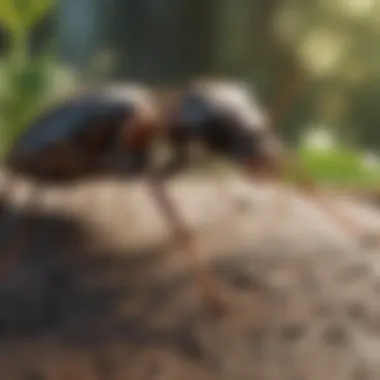
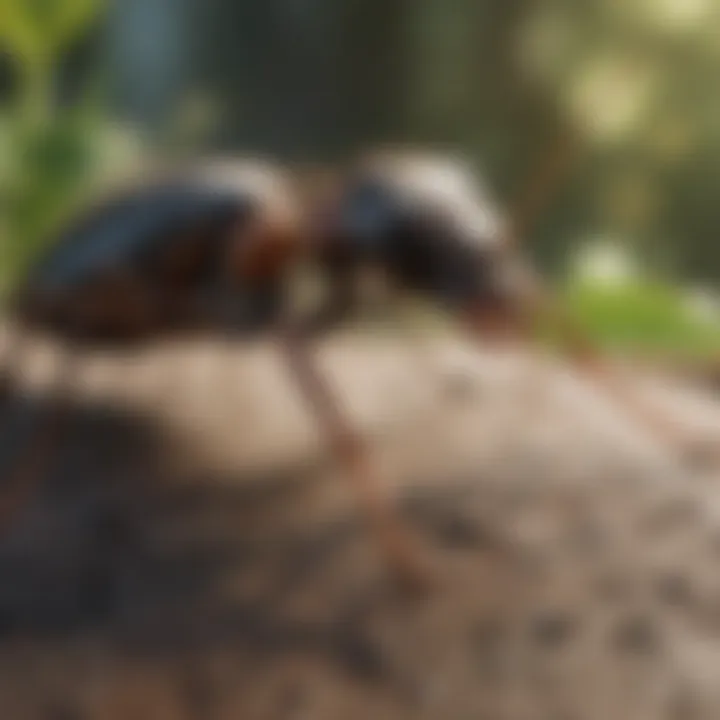
Natural solutions can also be economical. Many homeowners can create their own sprays using common household items that are less expensive than commercial chemical options. The DIY aspect adds an element of control, allowing users to customize mixtures to their specific needs. The solutions are often safe to use around children and pets when prepared and applied correctly.
Limitations of Natural Sprays
Despite their benefits, natural bug sprays come with certain limitations. One significant drawback is the variability in efficacy. Natural ingredients may not always provide immediate or long-lasting results compared to chemical alternatives. This inconsistency can be frustrating when dealing with a severe ant infestation.
Additionally, the preparation of natural sprays may require more time and effort. Homeowners need to experiment with different recipes and concentrations to find what works best for their specific situation. This trial-and-error approach can be inconvenient, especially for those seeking quick solutions.
Overall, while natural bug sprays contribute positively to ant management, potential users should carefully assess their needs, the ant infestation level, and the effectiveness of the chosen ingredients. Understanding both their strengths and limitations allows for more informed decisions in pest control.
Application Methods
Understanding how to apply bug sprays is crucial for effective ant control. It is not merely about the product you choose but also how you employ that product in your environment. Proper application methods can enhance the efficacy of the spray, minimizing waste and maximizing results. This section outlines the best practices for applying bug sprays effectively and emphasizes the importance of timing and frequency in pest control.
How to Apply Bug Sprays Effectively
To achieve desired outcomes when using bug sprays against ants, following the correct application techniques is essential. Here are some key steps to consider:
- Read the Instructions: Always start with the product label. Each bug spray comes with specific guidelines regarding dosage, safety precautions, and application techniques.
- Prepare the Area: Remove items in the vicinity of the infestation. This can include food, plants, or other potential attractants. It is helpful to clean surfaces where ants are commonly seen. This reduces chances of the ants being attracted back.
- Use Appropriate Tools: Depending on the formulation, you may need different tools. For instance, sprays with fine mist nozzles can cover wider areas, while pumps or baits may be required for targeted application. Ensure you have gloves and a mask for safety.
- Target Ant Trails: Identify and focus on the paths ants take. Spraying along these trails can disrupt their movement and eliminate the colony more effectively.
- Follow Technique: Aim for a thorough and even application. Move the spray nozzle at a consistent distance from the surface, ensuring not to oversaturate any single area. This optimizes contact with ants without causing unnecessary product waste.
- Check Weather Conditions: Windy or rainy weather can affect your application. Ideally, spray during dry conditions to prevent dilution or drift.
Effective application not only treats the current infestation but also helps in preventing future occurrences.
Timing and Frequency of Application
When it comes to applying bug sprays, timing can significantly influence efficacy. Here are some factors to consider:
- Initial Application: Apply the bug spray as soon as you notice ant activity. Early intervention often leads to quicker and more complete eradication of the problem.
- Observe Behavior: After your initial application, monitor the level of ant activity. If you see a decrease in sightings, that is a positive sign. However, if they persist, a repeat application might be necessary.
- Recommended Frequency: Most bug sprays recommend reapplication after a certain period. Be sure to follow the product instructions, as overuse can create resistance among ant populations.
- Seasonal Considerations: Ant activity varies by season. For example, during warmer months, ants tend to be more prevalent. Plan your application schedule accordingly to minimize risks when ants are most active.
"Effective control of ants relies not only on the type of spray used but also on how and when it is applied."
Regular evaluations of your application methods can help in adapting to pest behavior changes, ensuring sustained efficacy of your chosen spray.
Evaluating Product Efficacy
Evaluating product efficacy plays a crucial role in the decision-making process for homeowners looking to address their ant issues. Understanding how well a bug spray works against specific types of ants can ensure that individuals make informed choices tailored to their unique circumstances. It is not enough to simply purchase a product and apply it; discerning the intricacies of its effectiveness can prevent wasted time and resources, while also contributing to a more sustainable approach to pest control.
Several elements must be taken into account when assessing the efficacy of bug sprays. First, an awareness of the ant species being targeted is essential as different ants respond variably to different chemical or natural formulations. For instance, grease ants may not react the same way to a product designed primarily for carpenter ants. Second, the environment in which these sprays are applied can dramatically impact how effective they are. Factors such as humidity, temperature, and presence of food sources for the ants can either enhance or diminish the desired effects of the product. This understanding lays the groundwork for successfully managing ant populations in various living situations.
Factors Affecting Efficacy
When evaluating the efficacy of bug sprays, various factors come into play:
- Concentration of Active Ingredients: The higher the concentration, the more effective a product may be, assuming it is appropriate for the specific ant species.
- Application Method: How a product is applied—spray, bait, or granule—can affect its penetration and overall impact.
- Ant Behavior: Understanding the habits of specific ants, such as their nesting patterns or foraging routes, can dictate where and how to apply the spray for maximum efficiency.
- Environmental Conditions: Elements like temperature and humidity influence evaporation rates and can affect product longevity.
Customer Reviews and Ratings
Customer reviews and ratings serve as valuable resources when assessing the performance of bug sprays. They provide real-life insights into how products perform under practical conditions. Many homeowners share their experiences regarding not just the effectiveness against ants, but also the application process and any side effects they noticed.
- Real-World Efficacy: Feedback from customers reveals whether a bug spray successfully eliminated ants or if it fell short of expectations. This information can guide future buyers towards more effective solutions.
- Safety Concerns: Customers often highlight issues related to safety, especially if they have children or pets, which are significant factors to consider.
- Ease of Use: Many reviews detail the application experience, indicating if the product is user-friendly or requires specialized equipment for proper use.
Ultimately, synthesizing customer reviews and ratings can offer a more balanced view of a product's strengths and weaknesses. The communal knowledge gained through these platforms can enhance the decision-making process for those seeking effective bug sprays against ant infestations.
"When it comes to bug sprays, real feedback is gold. It can save you from making costly mistakes."
In summary, the evaluation of product efficacy should encompass factors affecting performance as well as insights gained from customer experiences. This comprehensive analysis will arm homeowners with the knowledge they need for effective ant control.
Environmental Considerations
Understanding the environmental considerations related to bug sprays for ants is essential for responsible pest management. The impact of our choices on surrounding ecosystems can no longer be overlooked. Homeowners are increasingly aware of the potential harm that chemical pesticides can cause, not only to ants but also to beneficial insects, plants, and even pets. This section explores the effects of chemical sprays on ecosystems and offers sustainable pest management practices that prioritize environmental health.
Impact of Chemical Sprays on Ecosystems
Chemical bug sprays, while effective against ant infestations, come with risks. Once sprayed, these chemicals can runoff into surrounding soil and waterways, affecting a range of organisms. Studies have shown that certain ingredients can be harmful to pollinators like bees, which play a crucial role in plant reproduction and agriculture. Moreover, aquatic ecosystems can suffer from toxicity when chemical residues enter water bodies, harming fish and other wildlife.
Key points to consider include:
- Toxicity: Some ingredients may not only kill ants but can also have unintended consequences for non-target species.
- Bioaccumulation: Chemicals can accumulate in the bodies of organisms, leading to long-term ecological effects.
- Disruption of Food Chains: The death of one species can lead to the decline or overpopulation of others, causing imbalance in the ecosystem.
"Integrated pest management (IPM) is vital to reduce adverse effects on the environment while solving pest problems."
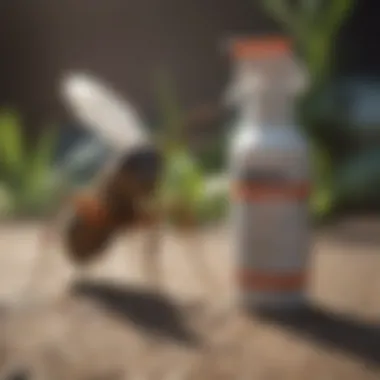
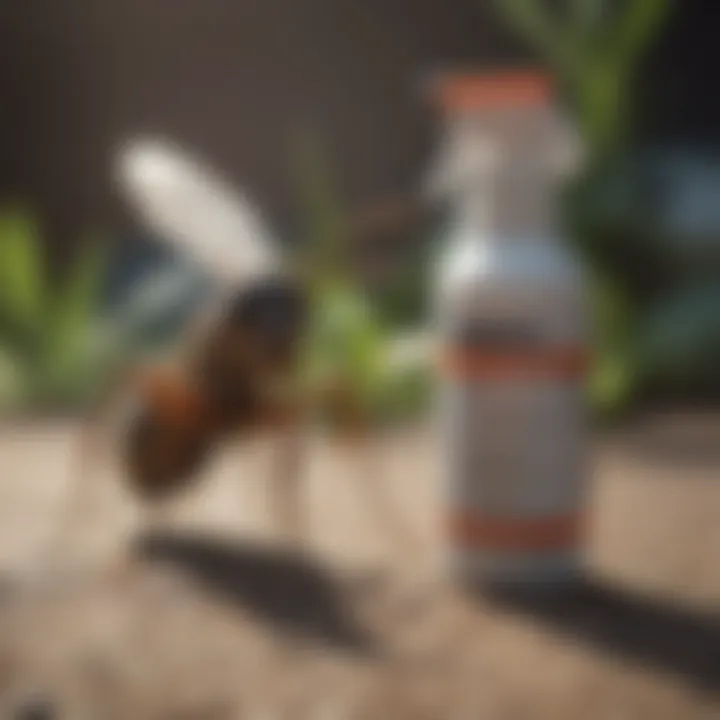
Awareness of these impacts can guide choices in pest control toward more sustainable alternatives.
Sustainable Pest Management Practices
Sustainable pest management practices provide a balanced approach to dealing with ant infestations while considering environmental health. These practices emphasize long-term strategies over short-term solutions. Some effective sustainable methods include:
- Habitat Modification: Reducing access to food and water can deter ants without the use of sprays. Sealing entry points and keeping food stored can drastically minimize infestations.
- Natural Predators: Encouraging the presence of natural predators, such as certain birds and beneficial insects, can help control ant populations without chemicals.
- Use of Biopesticides: Products derived from natural materials are generally less harmful to the environment than traditional pesticides. Options like diatomaceous earth can be effective against ants while being environmentally friendly.
- Monitoring and Evaluation: Regularly monitoring ant populations can help identify problems early, allowing for targeted intervention strategies that are less disruptive to the environment.
Utilizing these approaches helps minimize adverse environmental impacts while effectively managing pest problems. By being informed and making conscientious choices, homeowners can protect not only their spaces but also the ecosystems around them.
DIY Bug Spray Recipes
Creating your own bug spray for ants can be a practical solution for those who prefer natural methods or wish to avoid commercial chemicals. DIY bug sprays often utilize common household items, making them accessible and economical. Moreover, they allow for better control over the ingredients used, which is particularly important for those with children or pets in the home. Understanding how to formulate an effective DIY solution is key for anyone looking to manage ant infestations.
Simple Homemade Formulas
Several straightforward formulas can help in crafting a bug spray to deter ants. Below are a few simple options:
- Vinegar and Water Solution: This mixture can be particularly effective due to vinegar's acidity. Mix equal parts of white vinegar and water in a spray bottle. Spray directly on ants and their trails. The strong smell may disrupt their pheromone trails, making it harder for them to navigate.
- Soap and Water Mixture: Combine a few drops of dish soap with water in a spray bottle. The soap clogs the breathing pores of ants, which can lead to their demise. Be cautious not to use too much soap as it can cause excessive harm to beneficial insects as well.
- Essential Oil Sprays: Essential oils like peppermint or tea tree oil can act as natural repellents. Combine ten drops of your chosen oil with water in a spray bottle. Spray around entry points to deter ants from coming in.
These formulas are simple to prepare, ensuring that anyone can craft effective sprays without specialized knowledge.
Effectiveness of DIY Solutions
The efficacy of DIY bug sprays largely depends on several factors. First, the ingredient quality can influence results. For example, fresh vinegar or pure essential oils tend to be more effective than those that are diluted or past their prime.
Additionally, application method plays a crucial role. Targeting the ants directly and spraying their trails will yield better results than general use around the home. Furthermore, regular application is often necessary. Ants may return, necessitating multiple rounds of spraying.
A significant aspect to consider is that DIY solutions may not always provide immediate results. Unlike commercial sprays, which often contain potent chemicals, homemade options traditionally work slower. Therefore, patience is required when using these remedies. Despite these considerations, many individuals find satisfaction in taking a hands-on approach to pest control, making DIY solutions appealing.
"DIY bug sprays allow homeowners to take charge of pest control without reliance on harsh chemicals."
Understanding the limitations and benefits of these homemade formulas is crucial in deciding whether they are the right choice for your pest problem.
Professional Pest Control Options
Professional pest control is crucial in addressing ant infestations effectively, especially when common home solutions fail to yield results. These services bring expertise in pest behavior, infestation assessment, and specific treatment methods tailored to various ant species. Homeowners must weigh the benefits and considerations before deciding on this route.
When to Seek Professional Help
There are distinct scenarios when returning to a professional is necessary. First, if the ant infestation is severe or difficult to identify, trained pest control specialists can diagnose the problem and suggest effective solutions. Frequently, standard methods like bug sprays may not penetrate deep into nests or colonies, leading to persistent issues.
Additionally, some ant species require special treatment. For instance, carpenter ants can cause structural damage, while fire ants pose a threat through painful stings. It is advisable to consult experts when facing these specific types. Moreover, overwhelmed homeowners who lack time or experience may find it more efficient to hire professionals who can execute a comprehensive treatment plan.
What to Expect from Professional Services
When engaging a pest control service, clear expectations should be established. Professionals typically conduct an initial assessment to identify the extent of the infestation and the species involved. Subsequent steps may involve a combination of chemical and natural treatment options, all customized based on the specific situation.
"Professional pest control services extend holistic solutions for long-term ant management, addressing both immediate concerns and preventing future infestations."
After treatment, an inspection is necessary to ensure that the methods used have been effective. Many companies will also advise on preventative measures to reduce the risk of future infestations. Homeowners should expect follow-up visits or consultations, ensuring detailed tracking of the treatment's success.
In summary, professional pest control options provide valuable resources in extreme cases of ant infestation. They bring knowledge and professional-grade products to help manage the problem thoroughly, offering peace of mind to homeowners struggling with invasive ants.
Finale and Recommendations
In the battle against ant infestations, understanding the various methods and products available is crucial for effective management. This article provides an overview of chemical and natural bug sprays, effective application methods, and important safety precautions. As homeowners and pest management professionals navigate the options, it is essential to weigh the benefits and limitations of each approach.
Summarizing Key Points
To summarize some key points, here are the main considerations:
- Types of Bug Sprays: Familiarity with both chemical and natural sprays offers flexibility in choosing a solution that aligns with personal values and environmental concerns.
- Efficacy: Understanding the active ingredients and their mechanisms can help users select sprays that specifically target the ants prevalent in their area.
- Application Techniques: Proper application is necessary for achieving maximum effectiveness. Misapplication can lead to unsatisfactory results.
- Safety Precautions: Recognizing the potential risks associated with chemical sprays ensures that users protect their families and pets.
- Professional Help: In some situations, professional pest control services may yield faster and more thorough results, especially for severe infestations.
An informed choice about bug sprays can lead to successful ant management and provide peace of mind.
Final Thoughts on Ant Management
Managing ants requires a nuanced approach. Homeowners should not only focus on eradication but also preventive measures. Regular cleaning and sealing entry points minimize future infestations. Adopting an integrated pest management strategy brings together monitoring, prevention, and intervention.
Ultimately, the path taken for ant control should reflect the homeowner's individual situation and preferences. Being informed allows for better choices, leading to effective, sustainable solutions.
"A holistic approach to ant management not only eliminates the current problem but also safeguards against future invasions."
By applying the knowledge gained from this guide, households can achieve effective results in their quest for a bug-free environment.







